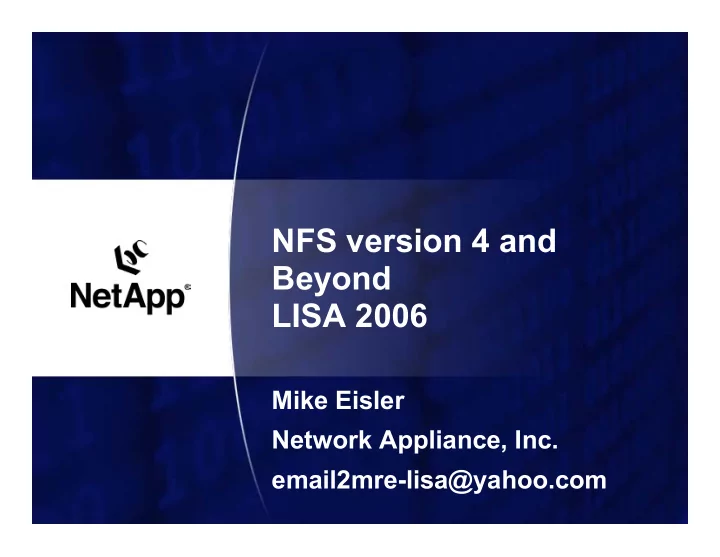

NFS version 4 and Beyond LISA 2006 Mike Eisler Network Appliance, Inc. email2mre-lisa@yahoo.com
Outline Top 5 things to you need to know about NFSv4 – Comparison of NFSv3 and NFSv4 – Benefits – Misconceptions – Who has it? – Drawbacks Basic concepts Futures Pointers Questions NetApp 2
Comparison of NFSv3 and NFSv4 NFSv3 NFSv4 A collection of protocols (file, One protocol to a single port mount, lock, status) (2049) Stateless Lease-based state UNIX-centric, but seen in Supports UNIX and Windows Windows too file semantics Deployed with weak Mandates strong authentication authentication 32 bit numeric uids/gids String-based identities Ad-hoc caching Real caching handshake UNIX permissions Windows-like access Works over UDP, TCP Bans UDP Needs a-priori agreement on Uses a universal character character sets set for file names NetApp 3
Benefits Mandates strong security – Every NFSv4 implementation has Kerberos V5 – You can use weak authentication if you want Finer grained access control – Go beyond UNIX owner, group, mode Read-only, read-mostly, or single writer workloads can benefit from formal caching extensions Multi-protocol (NFS, CIFS) access experience is cleaner – NFSv4 has an OPEN operation; thus CIFS clients can’t disrupt NFSv4 clients Byte range locking protocol is much more robust – Recovery algorithms are simpler, hence more reliable NetApp 4
Misconceptions NFSv4 is a new protocol, so I can use more than 16 supplemental gids? – No, the 16 gid limit is a property of the weak authentication flavor of the remote procedure call – Use Kerberos V5, and you can go beyond 16 gids • Limited primarily by server’s operating system and server’s local file system I need NFSv4 in order to use Kerberos V5, right? – No, Kerberos V5 works on NFSv[23] too and has for years on AIX (IBM), EMC, Hummingbird, Linux, NetApp, Solaris NetApp 5
Who Has NFSv4? IBM (AIX 5.3) EMC Hummingbird Network Appliance (best is 7.x) FreeBSD 5.3 Linux 2.6 (Fedora Core) OSX (Rick Macklem, not Apple) Solaris 10 2 others tested at Connectathon 2006 NetApp 6
Basic Concept: Delegation A delegation is a grant from an NFSv4 server to a client for rights to perform read-only or read/modifying operations on a particular file With a read-only delegation, multiple NFSv4 clients can cache a file with impunity – With NFSv3, a client that caches a file would periodically send GETATTRs to re-validate its cache – Some workloads are absolutely hammered with GETATTRs even after the customer carefully tunes his clients to cache the workload’s working set With a write delegation, a single NFSv4 client can cache and modify a file with impunity – Useful for applications like home directories where the data set owner tends to be the only reader and writer NetApp 7
Basic Concept: Referrals NFSv4 has hooks for data migration When a file system moves from one server to another, the NFSv4 client receives an NFS4ERR_MOVED error from the original server The NFSv4 client issues a GETATTR for the “fs_locations” attribute to tell the client which server has the file system, and the location within the new server Removes NFS mount/server IP address straitjacket NetApp 8
Drawbacks Fewer implementations than NFSv3 – OSDL has publicly pronounced NFSv4 (kernel.org) as “ready” • Enterprise Editions of major Linux distributions don’t fully support NFSv4 or Kerberized NFS Not all features uniformly implemented right now – NFSv4 referrals turned out to be the most compelling to customers, but are the least completely implemented of all NFSv4 features NetApp 9
Futures: NFSv4.1 Sessions and Exactly Once Semantics Directory delegations RDMA – Origins in Direct Access File System (DAFS) – Early access (Linux) for NFSv[34] available now Parallel NFS – Single File I/O can be served by multiple data servers – E.g. a file blocked at 1024 bytes, striped over 3 servers, might have • offset 0 served by data server0 • offset 1024 served by data server1 • offset 2048 served by data server2 • offset 3072 served by data server0 • … – 3 styles of data servers: blocks, files, objects – Linear scaling is possible NetApp 10
Pointers www.nfsv4.org ietf.org/html.charters/nfsv4-charter.html – NFSv4 working group page at IETF www.ietf.org/rfc/rfc3530.txt - The protocol specification for NFSv4 Blogs – Some co-authors of NFSv4: • Eisler: nfsworld.blogspot.com • Shepler:blogs.sun.com/roller/page/shepler/Weblog?catname=%2 FNFS Linux NFSv4 client: – wiki.linux-nfs.org/index.php/Main_Page – linux-nfs.org/cgi-bin/mailman/listinfo/nfsv4 OS X client: – ftp.cis.uoguelph.ca:/pub/nfsv4/darwin-port/xnu-client.tar.gz Linux NFS/RDMA client and server: http://sourceforge.net/projects/nfs-rdma/ NetApp 11
Questions? NetApp 12
Backup Slides NetApp 13
Acronyms ONC RPC – Open Network Computing Remote Procedure Call: used by NFS GSS – Generic Security Services: allows security mechanisms like Kerberos V5 to plug into a common programming interface for security AUTH_SYS – UNIX System Authentication: weak authentication for ONC RPC and NFS RPCSEC_GSS – GSS-based security flavor for ONC RPC and NFS ACE – Access Control Entry: consisting of a uid or gid, permissions, deny/allow ACL – Access Control List: a list of ACEs for a file GETATTR – NFS Get Attribute operation UTF8 – (8-bit Unicode Transformation Format) is a variable-length encoding for Unicode. US-ASCII characters go out in 8 bits; other locale character sets require 16 bits or more NetApp 14
Recommend
More recommend